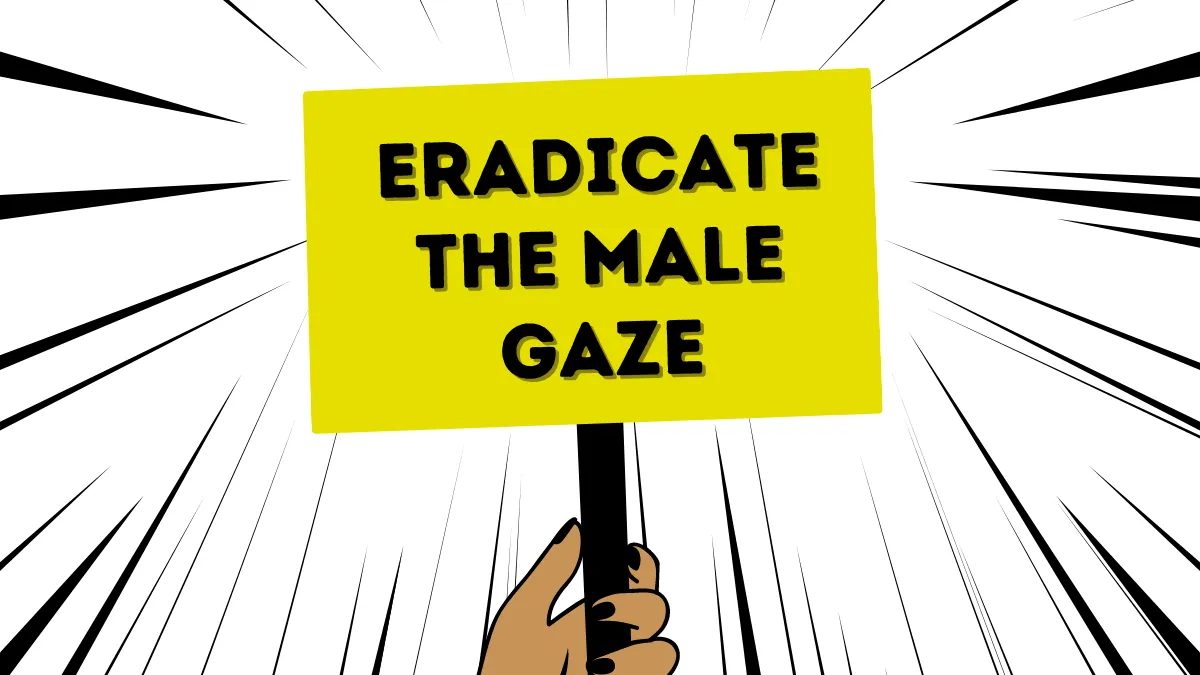What is the “Male Gaze?”
This blogpost discusses the prevalence of patriarchal values in mainstream society, and their impact on the United States of America, as well as the global community. By acknowledging and eradicating the male gaze in American society through female-centered governmental policies, the US can come to the aid of women internationally by exemplifying what it means to live in an egalitarian society.
The reason why this view should be considered is because de-centering values that set male dominance as the standard will prevent women from continuing to the “othered.” Once women can depart from the margins of society in this way, true equality can be achieved.
Defining the Male Gaze
In feminist writer Margaret Atwood’s The Robber Bride, she writes:
Male fantasies… is everything run by male fantasies? Up on a pedestal or down on your knees, it’s all male fantasy: that you’re strong enough to take what they dish out, or else too weak to do anything about it. Even pretending you aren’t catering to male fantasies is a male fantasy: pretending you’re unseen, pretending you have a life of your own, that you can wash your feed and comb you hair unconscious of the ver-present watcher peering through the keyhole, peering through the keyhole in your own head, if nowhere else. You are a woman with a man inside watching a woman. You are your own voyeur.
This quote gained popularity in recent years for being a driving force behind the colloquialization of “male gaze” and the discourse surrounding it. This begs the question: what is the male gaze? According to Atwood, the “male gaze” (in a colloquial sense) is the idea that most things in mainstream society are planned, developed, controlled, and realized by men. The opinions and actions of men are prevalent in aspects of everyday life. This includes societal attitudes and standards of what is socially acceptable for women.
Setting the Standard
Because men set this standard, and are patronized as the superior gender in mainstream society (which they were responsible for creating) women must adhere to these standards in order to be able to survive in society. These societal attitudes include the idealization of traditional femininity.
This includes thinness, politeness, and agreeability. In addition, The heterosexual male gaze rewards the sexualization and objectification of the female body. It is important to note that despite the idealization of certain aforementioned Eurocentric traits, any physical trait can be idealized and objectified under thimble gaze. Janice Loreck, a teaching associate at the University of Monash School of Film, Media, and Journalism says,
The “male gaze” invokes the sexual politics of the gaze and suggests a sexualized way of looking that empowers men and objectifies women. In the same male gaze, woman is visually positioned as an “object” of heterosexual male desire. Her feelings, thoughts and her own sexual drives are less important than her being “framed” by male desire.
Where did the Male Gaze Originate?
The male gaze theory, though currently colloquialized as sociological phenomenon, originates from feminist film theory. The term was coined by film theorist Laura Mulvey. She developed this theory in her 1975 essay, Visual Pleasure and Narrative Cinema. Mulvey draws on psychoanalytical works of Sigmund Freud and Jacques Lacan to develop this theory. Mulvey asserts that in the male gaze phenomenon, the man is the spectator, and the female is the object to be looked at.
When developing the male gaze theory, Mulvey builds on the ideas of Freudian scopophilia, phallocentrism, and the Lacanian Mirror phase. Scopophilia is described as the pleasure that is derived from looking at someone or something. In Freudian Scopophilia, pleasure is derived from the presumption made by the onlooker that the object they are perceiving is unaware of their own observation. The person being perceived is known as the “objectified other.” In this case, the objectified other has no control over the situation regarding their observance. The observation is non-consensual, and thus the objectified other is victimized.
The Objectified Other
In some cases though, the objectified other is aware of their surveillance, in which case pleasure is still derived from their perception by the onlooker anyways. According to Mulvey, cinema thrives on deals of this kind of “voyeuristic separation” because onlookers are able to project their own desires onto the performer. She says that Scopophilia, in addition to allowing for projection onto an objectified other, makes room for narcissism due to its emphasis on the human form. This stems for the Lacanian “mirror phase.” In regard to Lacan, Mulvey says,
The mirror phase occurs at a time when the child’s physical ambitions outstrips his motor capacity… his recognition of himself is joyous in that he imagines his mirror image to be more complete.
According to Mulvey, the mirror phase represents the development of one’s ego and the realization of “myself”. According to Mulvey, when this idea is applied to Scopophilic pursuits, (such as film) narcissism can become pervasive both within the onlooker and the objectified other. This idea has made a departure from film theory into mainstream feminism, and is considered to be ubiquitous in all industries and aspects of non-male life.
Hillary Clinton: A Male Gaze Case Study
The male gaze has many ways of impacting the lives of women in the United States. The impact of theses mechanisms can be both covert and apparent. Fitness, cosmetics, and fashion are just a few examples of the many industries that, despite catering to women, thrive on the male gaze. This is because they advertise products that women can use to look better for men, while simultaneously setting the standards for what women should look like.
This setting of standards presents itself in various forms, the most obvious of which is the models companies choose to highlight in their marketing initiatives. The executive positions of America’s most famous cosmetic, fashion, and fitness industries are all held by men. The chief executive officers of Nike, Estee Lauder, Mac, Lululemon, and Target are all men. These companies are just a few examples of the many companies that are woman-targeted, but man-operated.
The private sector, however, is not the only aspect of American life that is controlled by the male gaze. Although it is less obvious, the male gaze is as ubiquitous in public life as it is in the pirate sector. In government, however, the male gaze may present itself in different ways. The most notable case which can be examined to demonstrate the prevalence of the male gaze in American government is the political career of former Secretary of State, Hillary Clinton.
Hillary Clinton’s Political Career
Clinton has had a tumultuous political career and is considered to be one of the most powerful women in American politics. She has served as a senator, a secretary of state, and was nominated as the democratic candidate for the General Election of the President of the United States in 2016. She has come closer than any woman in American history to winning get presidency.
Clinton’s career is notable in that she has had to deal with many criticisms that her male counterparts have not. How she dresses, speaks, and carries herself are all subject to extra scrutiny because of her gender. She has faced backlash for things link “dressing like a lesbian” and being a “nasty woman.”
One article highlights how, in an attempt to humanize her, Hillary’s colleagues will often reference her wifehood and motherhood as a driving force behind her positive character and loving personality. Her relation to men (wife) and playing a role that serves them (mother) are made to be cornerstones of her humanity. This is problematic because her educational and political achievements are not enough for her to be taken seriously.
Misogyny in Politics
In this case, her relation to men must be emphasized to legitimize her as a qualified politician, and suitable candidate for public office. Clinton herself cites misogyny as one of the reasons why she lost the 2016 presidential eection. She says in an article from the Washington Post that “Certainly, misogyny played a role. I mean, that just has to be admitted.” While it may be easy to cite personal bias and political vendettas as the reason why Clinton is making these statements, a study from the nonpartisan Barabara Lee foundation shows that her statement is not far off from factual occurrences. The study concluded that,
Women can’t just be themselves when they run for office. They constantly have to contemplate what their looks, clothes and smile (whether they smile) project to voters, in a way men don’t.
This quote shows that the electability of women largely depends on how likable they are to men, and how well they exemplify the “ideal object” of prevailing male fantasies, while also being perceived as strong enough to be able to hold political office. Because women must tread this difficult boundary carefully, it is harder for women to be successful in politics. Clinton is one of the many female politicians that have experienced this type of misogyny.
In Clinton’s case, this misogyny played a role in barring her from the highest political office in the United States of America. The consequences of decreases perceived electability when a woman fails to appeal to the male faze is perhaps the most covert weapon used to keep women out of political office. As a result, it is harder for policies that promote equality and fairness between men and women to become a reality. This is a significant source of inequality in American society.
FGM and the Male Gaze Abroad
It is evident that the male gaze is prevalent in American Society, but what about women in other nations? One extreme example of the male gaze manifesting into a punishment for the simple existence of women is female genital mutilation (FGM).
What is FGM?
Female genital mutilation is the alteration, injury, or removal of the female external genitalia. It is considered to be a gross violation of the Hippocratic oath in western medicine, but continues to be practiced because of social and cultural norms prevalent in the countries where these mutilations take place. The practice occurs largely to prevent women from expressing their sexuality, and as a phyiscal manifestation of male domination.
FGM can lead to serious health complications, such as the increased risk of HIV, excessive genital bleeding, and increased risk for infections. It is not a necessary procedure, and is only carried out for non-medical reasons. Further, it is seen as a way to preserve marriage and family honor, as well as maintain religious faith.
FGM as a Product of the Male Gaze
FGM is a product of the male gaze because it demonizes the erogenous nature of clitoral stimulation (the main organ subject to injury during female genital mutilation), which is seen as unnecessary. The clitoral region is trivialized by the male gaze because it is not seen as essential to childbearing.
While the purpose of the female clitoral area is heavily under-researched, the current prevailing medical consensus is that its only current purpose is sexual stimulation. Because of this, it is seen as unimportant and shameful in societies that conduct female genital cutting. This is because, under patriarchal ideology (and as a result of the male gaze), adult female sexual pleasure is demonized, and is not a priority when conducting sexual acts.
While this practice is illegal in the United States, it is prevalent in Sudan, Egypt, Somalia, Mali, and Ethiopia. This is just one example of how the male gaze impacts women abroad. Across Asia, Africa, and the Middle East, women do not have the right to drive, own property, perform non-domestic labor, or leave a house without a male escort. All of these restrictions exist solely because of the way men in society perceive women.
The Responsibility of the United States
The US has a unique role when it comes to eradicating the male gaze. If it is something that can be achieved here, other countries will follow, and the implications will be liberating for women internationally.
Lakshmi Puri, the former UN assistant secretary-general and deputy executive director of UN Women, in the film documentary Equal Means Equal, implores women in the west to pressure their governments for increased rights and liberation. She says that this is important because western women can express their views with less risk than women in the east. Although western women and non-men are still marginalized, albeit more covertly, there is more of an opportunity for them to be vocal without the threats of losing their job, family, or lives.
Why is Eradicating the Male Gaze Important?
Eradicating the male gaze is not only essential for the continued liberation of women, but also plays a key role in the securing of their human rights. Article 2 of the United Nations Declaration on Universal Human Rights states,
Everyone is entitled to all the rights and freedoms set forth in this Declaration, without distinction of any kind, such as race, colour, sex, language, religion, political or other opinion, national or social origin, property, birth or other status. Furthermore, no distinction shall be made on the basis of the political, jurisdictional or international status of the country or territory to which a person belongs, whether it be independent, trust, non-self-governing, or under any other limitation of sovereignty.
According to the United Nations, every human being, regardless of their gender, deserves to be treated equally, without discrimination. If forces like the male gaze continue to be an insidious driving force behind the construction of societal values, women as a whole will never know true liberation. This idea can be implemented in conjunction with the United Nations Sustainable Development Goal 10: Reduced inequalities. Because there is no dominant male-affecting equivalent to the male gaze, it can be concluded that the male gaze is a considerable source of sexism and misogyny.
Important First Steps to Eradicating the Male Gaze
It is important to understand where the male gaze comes from and the impact that it has on women around the world because these ideas can be built upon to formulate solutions to the male gaze, as well as formulate steps that can be taken to dismantle this mechanism. Dismantling the male gaze as a mechanism of domination is an important step in the progression of the feminist movement, the protecting the human rights of women, and allowing them to enjoy the rights which are inherently theirs.
All of the aforementioned injustices that plague women in society can be solved individually, but should not be eradicated in a vacuum. Decreasing barriers to entry for women in American politics will consequently help empower women in other nations due to the interconnected nature of humanity and global society.
Though these solutions sound far from reality, there are basic steps that can be taken domestically to catalyze this reality. One simple way that anyone, regardless of their background can aid in these efforts is to elect women to political office, and empower those around them to do the same. With more women in political office, more care and attention will be taken to pass legislation that protect and aids women.
With the female perspective as a prevalent force in all branches of American government, issues that impact women can be prioritized. Single mothers, female students, women in same-sex relationships, young girls, and many other groups can all benefit. This impact of decentering the male experience will not only benefit cisgendered women, but trandgender women and men, and gender non-conforming individuals as well.
Moving Forward
De-constructing the male gaze will improve the lives of cisgendered men as well, because ideas that are perpetuated by the same system which oppresses women, such as emotional stoicism and toxic masculinity, will also be de-constructed. This de-construction will have an impact on how men view themselves in society in relation to all genders. This will be beneficial to the mental health of mean and lead to decreased male suicide rates.
Everyone benefits from female liberation, and it will take a diverse group of advocates to make this vision a reality.
If you enjoyed this article, you may be also enjoy these!
- Audre Lorde & Harriet Martineau: Progressions in Feminist-Abolitionist Thought
- A Definition of Social Justice for Sociologists
- Gender-based Violence and a Global Agenda for Social Justice
- Gendered Experiences, Religiosity, and Well-being of Women during COVID-19
- The Girl Child and Gender Inequality: A Sociological View
- The Burgeoning Digital Gender Divide in India








